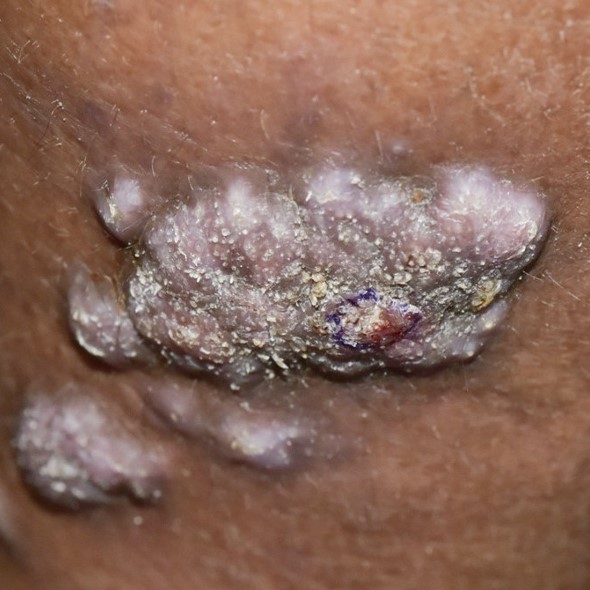Pembrolizumab-Induced Hypertrophic Lichen Planus in Patient with Hepatocellular Carcinoma
Keywords:
Hypertrophic lichen planus, Pembrolizumab, Cutaneous adverse event, Anti-PD-1 receptorAbstract
Pembrolizumab, an anti-programmed cell death-1 (PD-1) antibody, is a highly effective targeted therapy for many cancers, including hepatocellular carcinoma (HCC). Besides the excellent efficacy, one of the major reported downsides of this drug are the cutaneous adverse events, which can be presented in various forms. In this case report, we demonstrate a case of hypertrophic lichen planus (LP) after receiving pembrolizumab for 1 month. The initial diagnosis was made using dermoscopy and the diagnosis was confirmed by skin biopsy. Our patient was treated with intralesional corticosteroid which provided an excellent outcome. After the treatment, this patient can resume HCC treatment, using pembrolizumab. Hypertrophic LP is an unusual AE of pembrolizumab, the correct diagnosis and early treatment are critical for drug continuation.
References
Sanlorenzo M, Vujic I, Daud A, et al. Pembrolizumab cutaneous adverse events and their association with disease progression. JAMA Dermatol 2015;151:1206-12.
Ellis SR, Vierra AT, Millsop JW, Lacouture ME, Kiuru M. Dermatologic toxicities to immune checkpoint inhibitor therapy: A review of histopathologic features. J Am Acad Dermatol 2020;83:1130-43.
Finn RS, Ryoo BY, Merle P, et al. Pembrolizumab as second-line therapy in patients with advanced hepatocellular carcinoma in KEYNOTE-240: a randomized, double-blind, phase III trial. J Clin Oncol 2020;38:193-202.
Lacouture ME, Wolchok JD, Yosipovitch G, Kähler KC, Busam KJ, Hauschild A. Ipilimumab in patients with cancer and the management of dermatologic adverse events. J Am Acad Dermatol 2014;71:161-9.
Coscarart A, Martel J, Lee MP, Wang AR. Pembrolizumab-induced pseudoepitheliomatous eruption consistent with hypertrophic lichen planus. J Cutan Pathol 2020;47:275-9.
Kunimasa K, Isei T, Nakamura H, et al. Proliferative CD8(+) PD-1(+) T-cell infiltration in a pembrolizumab-induced cutaneous adverse reaction. Invest New Drugs 2018;36:1138-42.
Hanumaiah B, Joseph JM. Role of dermoscopy in the diagnosis of hypertrophic lichen planus and prurigo nodularis. Indian J Dermatol 2019;64:341-5.
Michalak-Stoma A, Malkińska K, Krasowska D. Usefulness of dermoscopy to provide accurate assessment of skin cancers. Clin Cosmet Investig Dermatol 2021;14:733-46.
Sigurgeirsson B, Lindelöf B. Lichen planus and malignancy. An epidemiologic study of 2071 patients and a review of the literature. Arch Dermatol 1991;127:1684-8.
Masterson WM, Brown AM, Al Ameri MA, Patel AB. A retrospective chart review of management strategies for lichenoid eruptions associated with immune-checkpoint inhibitor therapy from a single institution. Cancer Treat Res Commun 2022;30:100506.

Downloads
Published
How to Cite
Issue
Section
License
Copyright (c) 2023 Thai Journal of Dermatology

This work is licensed under a Creative Commons Attribution-NonCommercial-NoDerivatives 4.0 International License.
เนื้อหาและข้อมูลในบทความที่ลงตีพิมพ์ในวารสารโรคผิวหนัง ถือเป็นข้อคิดเห็นและความรับผิดชอบของผู้เขียนบทความโดยตรงซึ่งกองบรรณาธิการวารสาร ไม่จำเป็นต้องเห็นด้วย หรือร่วมรับผิดชอบใดๆ
บทความ ข้อมูล เนื้อหา รูปภาพ ฯลฯ ที่ได้รับการตีพิมพ์ในวารสารโรคผิวหนัง ถือเป็นลิขสิทธิ์ของวารสารฯ หากบุคคลหรือหน่วยงานใดต้องการนำทั้งหมดหรือส่วนหนึ่งส่วนใดไปเผยแพร่ต่อหรือเพื่อกระทำการใดๆ จะต้องได้รับอนุญาตเป็นลายลักอักษรจากบรรณาธิการวารสารโรคผิวหนังก่อนเท่านั้น

